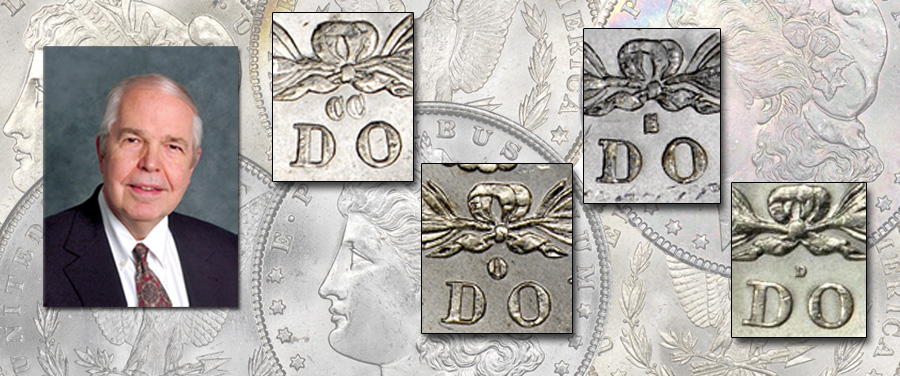
In my last article I focused on the creation of the Morgan silver dollar. In this part I will offer some insights into collecting this fascinating and popular series.
Today, the Guide Book of United States Coins lists close to 100 different dates and mintmarks from 1878 to 1921, plus some additional varieties. If you are just starting, I suggest you stick to basic dates and mintmarks, for starters. Later, add some of the varieties if you desire. One of my favorites is the 1900-O diagonal C over mintmark.
A few years ago I devised for Whitman Publishing the Optimum Collecting Grade (OCG), my idea of a grade in which a good value could be obtained for the amount paid. There is no hard and fast rule to determine such.
The 1886-O dollar as priced in the 2018 edition of the Guide Book gives these figures: VF-20 $39; EF-40 $45; AU-50 $75; MS-60 $900; MS-63 $3,500; MS-64 $11,000; MS-65 $185,000.
If I were putting together a set of Morgan dollars I would probably opt for MS-60 at $900, doing some cherrypicking so as to obtain a “high end” coin that might be equal to some certified at MS-61 or MS-62. If I were building a “high end” collection, I would not just go out and purchase a MS-65 at $185,000, even I could afford to do so. I would instead spend some time — maybe even a year or so — looking for a MS-64, ($11,000), cherrypicking until I found a certified coin that was just as nice as an MS-65. This is very realistic, as thousands of coins in various series certified by PCGS and NGC as MS-64 have been upgraded to MS-65 or even MS-66. This process would not only give me a very nice 1886-O dollar, but also a numismatic challenge and a lot of fun along the way.
Going back to basics. In my opinion, MS-63 is a nice OCG for the Morgan dollar series. Here’s a formula you might try: In the marketplace, buy one each different of all the MS-63 coins you can find priced up to $500. Cherrypick very carefully, as striking and, in particular, visual appeal, can vary widely; some MS-63 coins are ugly as a toad, and others are beautiful and the holders do not tell which is which.
When you do that, you will have the majority of the coins you need, including the historical and romantic Carson City issues of 1878, 1882, 1883, and 1884. This leaves you with a want list that will probably include 1879 CC, 1880-CC, 1881-CC, 1883-S, 1884-S, 1885-CC, 1886-O, 1889-CC, 1890-CC, 1891-CC, 1892-CC, 1892-S, 1893, 1893-CC, 1893-S, 1894, 1894-O, 1895, 1895-O, 1895-S, 1896-S, 1897-O, 1901, 1901-S, 1902-S, 1903-S, and 1904-S.
This amounts to 27 dates and mintmarks. You are already more than two-thirds of the way home!
What do to next? Well, I suggest that you splurge slightly and buy 1880-CC ($600), 1881-CC ($600), 1885-CC ($825), 1890-CC ($900), and 1891-CC ($775). This will give you the vast majority of a set of Carson City coins, perhaps the most interesting subset in Mint State. Now, you can maximize the knowledge and skills you have developed as you search out the more difficult and expensive dates and mintmarks. With that in mind, examine the other coins one by one. There is nothing wrong with a grade such as VF-20 or EF-40. After all, collectors of large copper cents of the 1790s find these grades to be typical and, often, the finest available in certain varieties. This makes 1879-CC affordable in VF-20 ($290), 1883-S in, say, AU-50 (which will probably have some luster ($140), 1884-S AU-50 ($290), 1886-O AU-50 ($75), 1889-CC VF-20 ($1,250, and very hard to find in that grade), 1892-CC, EF-40, ($450), 1892-S EF-40 ($300), 1893 EF-40 ($275), 1893-CC VF-20 (and very hard to find, $625), 1893-S VF-20 ($5,200), 1894 EF-40 ($1,000), 1895 Proof – you might want to omit this, as it is not a circulation strike – otherwise get set to spend several to tens of thousands of dollars. Now we come to 1895-O, VF-20 ($350), 1896-O AU-50 ($160), 1896-S EF-40 ($220), 1897-O AU-50 ($100), 1901 AU-50 ($280), 1901-S AU-50 ($200), 1902-S AU-50 ($275), 1903-S VF-20 ($205), and 1904-S VF-20 ($80).
In recent times various articles have made some collectors ashamed to own coins that are not gems, but this is rather silly. If instead of following my advice you opted to collect a full set of Morgan dollars at MS-63, you would be spending hundreds of thousands of dollars. Instead, under my formula, you can have the vast majority of coins in Mint State, and have enough money left over to also have a set of Peace silver dollars, 1901 to 1935, Eisenhower dollars, Anthony dollars, Sacagawea dollars, a full set of classic silver commemoratives 1892-1954, and more.
Do not mistake my intentions. If you bought Berkshire Hathaway stock or Microsoft stock at the outset, or won Powerball, then by all means build a set in MS-65! However, building a high grade Morgan dollar set will severely curtail your experience with other series unless you’re a person with substantial means. The Optimal Collecting Grade is worth exploring in other series as well. For some series, it is an absolute necessity.





